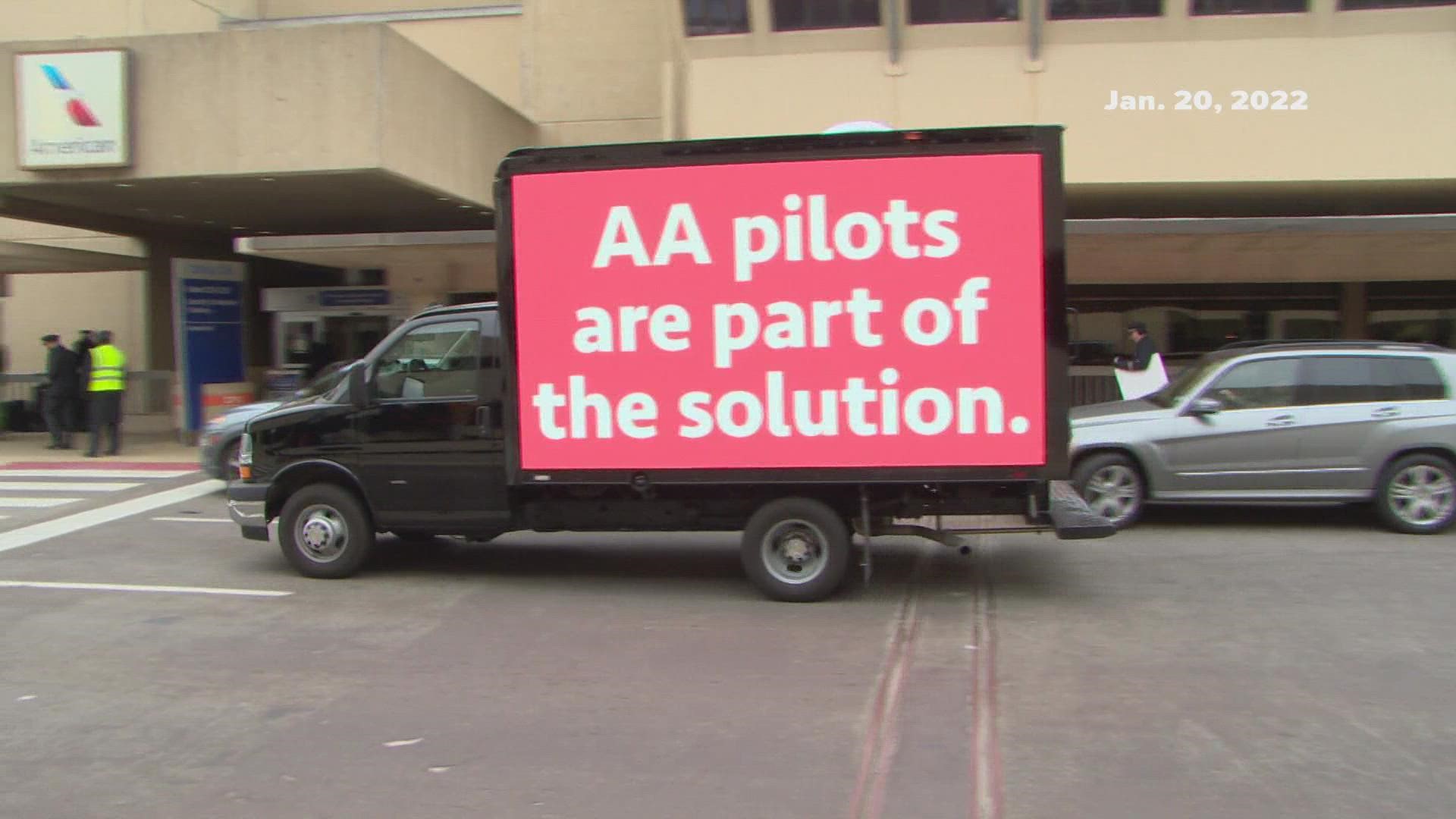FORT WORTH, Texas — Read this story and other North Texas business news from our content partners at the Dallas Business Journal
American Airlines Group Inc. removed more than 14,000 domestic flights from its December schedule as the carrier continues to limit capacity amid a shortage of pilots.
The cuts represent an 8% decrease in Fort Worth-based American's schedule for the month. The latest update to the carrier's schedule covers only the first two weeks of the month. Another update coming this weekend will likely include a similar reduction for the final two weeks of the month.
With the latest cuts, American's current schedule has the airline flying with 5.4% less capacity for the full year than in 2019. The company said in July it expects full-year capacity to be down 7.5% to 9.5% compared to 2019. Again, to get there, American (Nasdaq: AAL) needs to reduce its schedule even further.
In December, which includes the holiday travel season, American expects to have 158,156 flights. At this point, that's 2,369 more flights than in December 2021, but more than 19,000 fewer than in December 2019.
CEO Robert Isom told investors last month during an earnings call that the airline will continue to limit capacity "to the resources we have and the operating conditions we face" in order to improve reliability. The primary "resource" constraining American's ability to increase capacity continues to be pilots, particularly within its regional network. American has grounded 100 regional jets because it doesn't have pilots to operate the flights.
"We will size the airline for the demand that's out there," Isom said. "So right now, there's more demand than we'd like to be servicing."
Chief Commercial Officer Vasu Raja said during the July call that American would reduce capacity in "places where it can create the most operational benefit" by ensuring reliability and where it can accommodate customers the best.
Unsurprisingly, American's largest hub airports saw the most significant cuts in the new schedule. Dallas Fort Worth International Airport saw a reduction of 2,142 flights. Philadelphia International Airport, Chicago-O'Hare International Airport and Charlotte Douglas International Airport also each lost more than 1,000 flights.
The latest reductions come after American cut 28,000 scheduled domestic flights from its November schedule. The airline also cut a combined 15,000 flights from its September and October schedules.
Behind the cuts
American says that the schedule changes aren't "real cuts." During the most recent episode of American's "Tell Me Why" podcast, an executive explained how the company goes through its scheduling process.
Brian Znotins, vice president of network planning, said the airline uploads a "placeholder" schedule 331 days in advance and then publishes a final schedule 100 days before flights get off the ground. The placeholder schedule is based on a schedule from a previous season, or in this case 2019, while the actual schedule is based on information American gathers about how many flights it can realistically operate.
"Building the schedule takes time and it takes a lot of information and inputs from the operation," Znotins said. "The operation plays a really critical role in the schedule that we fly. The supportability we get from not only mainline but our regional partners will dictate how many flights we can operate in our network. We usually get that information maybe 120 days, 100 days, sometimes even closer with our regional partners to departure."
American's hubs have the most changes but each one has been "pretty stable since the pandemic started," Znotins said. Almost all of the hubs have been growing since the pandemic started and will continue to do so.
"Sometimes you’ll see a flight cut in one of our hubs but that’s just the schedule we’ve been running all year and now it looks like a cut when it’s not actually a cut," Znotins said.
While American's process may lead to some big headline numbers, Znotins said changing the schedule once provides less disruption for customers than constantly removing and adding flights. He also said American has always used the same scheduling process, but the operational reality has changed because of the pandemic. The company doesn't have the staffing — particularly within the pilot ranks — to operate with the same capacity as it did in 2019.
"In the past, those placeholder schedules have been outselling because we want to be able to offer a flight to passengers who want to make their plans that far in advance," Znotins said. "Frequently, that flight would operate largely at the time we had scheduled it. It may move five to 10 minutes when we publish the final schedule but it’s there for someone to book. But with the pandemic, obviously, those placeholder schedules became much less reflective of the actual schedules we would plan to fly when we publish them."
American would like to have a better placeholder schedule, Znotins said, but said the company has run into a chicken-or-the-egg type of problem.
"Unfortunately, to have a better placeholder, you need to know the schedule you are actually going to fly," Znotins said. "We don’t know that until we build the actual schedule. We have to go through the process to know what flights exist."
When the next schedule update comes out, Znotins said there will again be a number of changes from the placeholder schedule for the latter half of December. However, customers should not expect any surprises.
The airline does not want to "over-extend" itself and have to put customers through avoidable delays and cancellations, Znotins said.
"The media again may spin it as a surprise, but in fact, we're doing the same thing in November and December that we've been doing all year and did last year for the holidays as well," Znotins said on the podcast.

